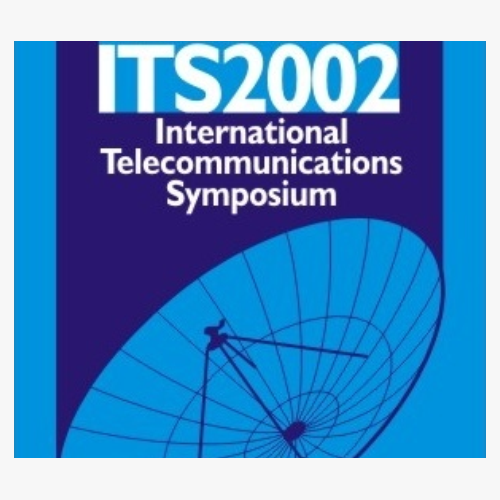
2002 International Telecommunications Symposium
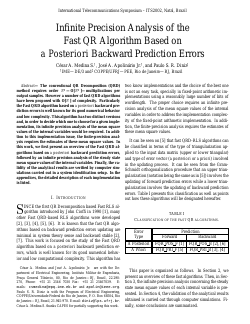
Infinite Precision Analysis of the Fast QR Algorithm Based on a Posteriori Backward Prediction Errors
César A. Medina S., José A. Apolinário Jr., Paulo S. R. Diniz
DOI: 10.14209/its.2002.320
Keywords:
Abstract
"The conventional QR Decomposition (QRD) method requires order N^2—O[N^2]— multiplications per output samples. However a number of fast QRD algorithms have been proposed with O[N] of complexity. Particularly the Fast QRD algorithm based on a posteriori backward prediction errors is well known for its good numerical behavior and low complexity. This algorithm has two distinct versions and, in order to decide which one to choose for a given implementation, its infinite precision analysis of the mean square values of the internal variables would be required. In addition to this implementation issue, the finite-precision analysis requires the estimates of these mean square values. In this work, we first present an overview of the Fast QRD algorithms based on a posteriori backward prediction errors, followed by an infinite precision analysis of the steady state mean square values of the internal variables. Finally, the validity of the analytical results are verified by computer simulations carried out in a system identification setup. In the appendices, the detailed description of each implementation is listed."Download

On the equivalence of the constrained RLS and the GSC-RLS Beamformers
Stefan Werner, José A. Apolinário Jr., Marcello L. R. de Campos
DOI: 10.14209/its.2002.326
Keywords:
Abstract
"This paper compares the transients of the constrained RLS (CRLS) algorithm with the generalized sidelobe canceller (GSC) employing an RLS algorithm. It is shown that the requirement for transient-equivalence is satisfied by the GSC structure using proper initialization, and any restriction concerning orthogonality of the matrices involved may be relaxed. This result differs from the more restrictive case for transient-equivalence of the constrained LMS (CLMS) algorithm and the GSC employing LMS algorithm. Simulations in beamforming and system identification applications confirms the theoretical results."Download

A New Method for Blind Channel Identification with Genetic Algorithms
Alysson Machado Costa, Romis Ribeiro de Faissol Attux, João Marcos Travassos Romano
DOI: 10.14209/its.2002.332
Keywords:
Abstract
"The first objective of this work is to analyze the suitability of a framework based on the use of genetic algorithms (GAs) to optimize blind equalization cost functions. This effort is motivated by advances in the field of GAs, as well as by recent breakthroughs in the study of blind techniques and their relations to the Wiener criterion. The second objective is to present and test a new proposal for blind channel identification. The method, whose success depends highly on the equalizer quality, was implemented through the established framework. The obtained results show that GAs are a valuable tool that can decisively aid filter adaptation and also demonstrate the efficiency of the identification proposal."Download
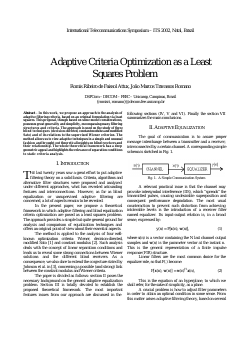
Adaptive Criteria Optimization as a Least Squares Problem
Romis Ribeiro de Faissol Attux, João Marcos Travassos Romano
DOI: 10.14209/its.2002.338
Keywords:
Abstract
"In this work, we propose an approach to the analysis of adaptive filtering criteria, based on an original formulation via least squares. This proposal, though based on some model considerations, possesses great generality and simplicity, encompassing many filtering structures and criteria. The approach is used on the study of three blind techniques (decision-directed, constant modulus and modified Sato) and of its relations to the supervised Wiener criterion. The method allows us to view adaptive techniques in a simple and unusual fashion and brought out theoretical insights on blind receivers and their relationship. The whole theoretical framework has a deep geometric appeal and highlights the relevance of separation conditions to static criteria analysis."Download
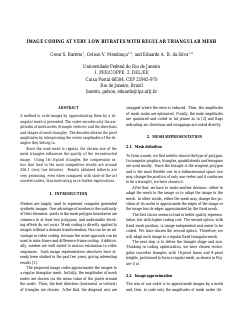
Image Coding at very Low Bit Rates with Regular Triangular Mesh
Cesar S. Barreto, Gelson V. Mendonça, Eduardo A. B. da Silva
DOI: 10.14209/its.2002.344
Keywords:
Abstract
"A method to code images by approximating them by a triangular mesh is presented. The coder encodes only the amplitudes of mesh nodes (triangle vertices) and the directions and shapes of mesh triangles. The decoder obtains the pixel amplitudes by interpolating the vertex amplitudes of the triangles they belong to. Since the used mesh is regular, the chosen size of the mesh triangles influences the quality of the reconstructed image. Using 16\u00d78-pixel triangles, the compression ratios that lead to the most competitive results are around 256:1 (very low bitrates). Results obtained hitherto are very promising, even when compared with state-of-the-art wavelet coders, thus motivating us in further explorations."Download
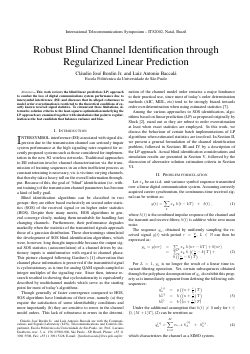
Robust blind channel identification through regularized linear prediction
Cláudio José Bordin Jr., Luiz Antonio Baccalá
DOI: 10.14209/its.2002.350
Keywords:
Abstract
"This work reviews the blind linear prediction (LP) approach to combat the loss of digital communications system performance due to intersymbol interference (ISI) and discusses that its alleged robustness to model order overestimation is restricted to the theoretical conditions of exactly known received signal statistics. To circumvent these limitations, alternative solution criteria to the least-squares optimization underlying the LP approach are examined together with simulations that point to regularization as the best candidate that balances variance and bias."Download

A Fast Algorithm for Signal Subspace Tracking Based on the Jacobi Method
Bruno Cosenza de Carvalho, Jacques Szczupak
DOI: 10.14209/its.2002.356
Keywords:
Abstract
"This work presents a new fast computational algorithm for decomposing a square signal symmetrical matrix, based on the Jacobi method. It is applied to real time systems with data acquisition updated almost sample by sample. The fast computational technique first involves the Data Matrix formation stage, so as to obtain the desired updated data matrix symmetry. In a second step it is developed the final fast algorithm implementation. A comparison is presented with the Golub-Kahan step algorithm, indicating gains and limitations of the proposed approach."Download

The Z Transform over Finite Fields
R. M. Campello de Souza, H. M. de Oliveira, D. Silva
DOI: 10.14209/its.2002.361
Keywords:
Abstract
"Finite field transforms have many applications and, in many cases, can be implemented with a low computational complexity. In this paper, the Z Transform over a finite field is introduced and some of its properties are presented."Download
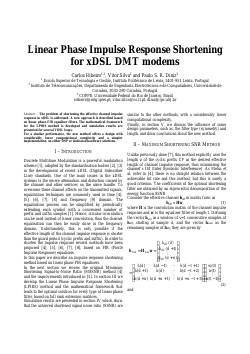
Linear Phase Impulse Response Shortening for xDSL DMT modems
Carlos Ribeiro, Vitor Silva, Paulo S. R. Diniz
DOI: 10.14209/its.2002.367
Keywords:
Abstract
"The problem of shortening the effective channel impulse response in xDSL is addressed. A new approach is described based on linear phase FIR equaliser filters. The mathematical framework for the LPIRS method is developed and simulation results are presented for several VDSL loops. For a similar performance, the new method offers a design with considerably lower computational complexity and a simpler implementation, on either DSP or dedicated hardware solutions."Download

A PDF Estimation-Based Blind Criterion for Adaptive Equalization
Charles C. Cavalcante, F. Rodrigo P. Cavalcanti, João Cesar M. Mota
DOI: 10.14209/its.2002.371
Keywords:
Abstract
"A blind criterion for adaptive equalization based on probability density function (pdf) estimation is proposed. The criterion measures the divergence between the pdf of an ideally equalized signal and the one from a parametric model resulting in a cost function that is a sort of entropy minimization of the equalizer output signal. It is also shown a link between the constant modulus (CM) criterion and the proposed one under certain circumstances. Some convergence properties are studied and the performance of the proposal is evaluated through simulations faced to a classical blind criterion."Download